University Report: WHO Intervention on Intimate Partner Violence
VerifiedAdded on 2022/09/12
|7
|929
|16
Report
AI Summary
This report critically examines the World Health Organization's (WHO) intervention guidelines for intimate partner violence (IPV). The report begins with an executive summary and table of contents, then introduces IPV as a global health issue. It identifies WHO as the organization addressing IVP and describes its intervention program, focusing on women-centered care, identification of IVP cases, and caring for survivors. The report critiques the guidelines, evaluating their inclusivity and network-building approach. The report highlights the importance of confidentiality and non-judgmental support for victims, as well as the need for early identification and diagnosis of IVP-related conditions. Finally, the report concludes by summarizing the implications of IPV and the effectiveness of WHO's intervention measures in providing comprehensive aid to victims and creating a network of intervention by catering to service providers. The report references key studies and guidelines to support its analysis.
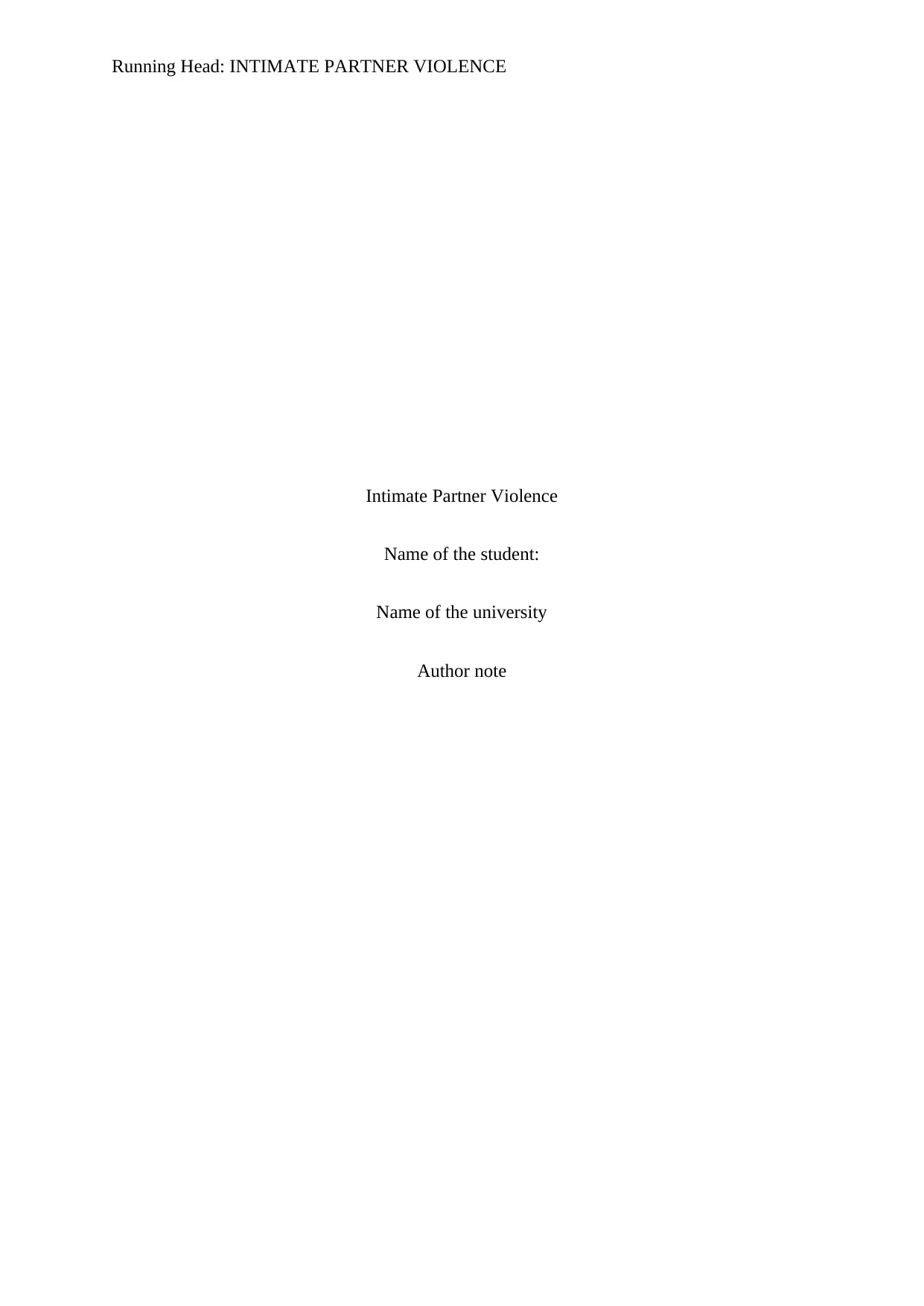
Running Head: INTIMATE PARTNER VIOLENCE
Intimate Partner Violence
Name of the student:
Name of the university
Author note
Intimate Partner Violence
Name of the student:
Name of the university
Author note
Paraphrase This Document
Need a fresh take? Get an instant paraphrase of this document with our AI Paraphraser
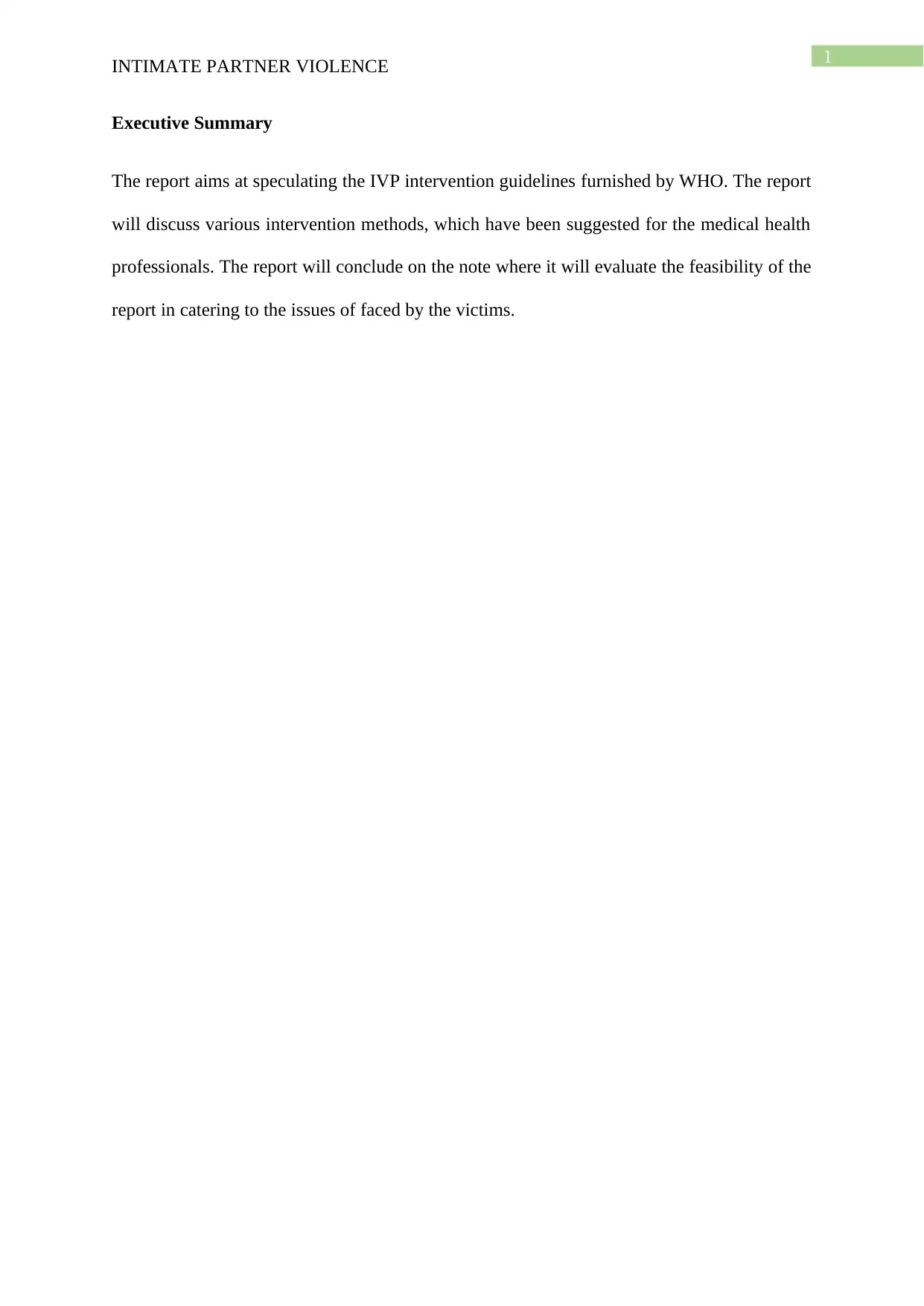
1
INTIMATE PARTNER VIOLENCE
Executive Summary
The report aims at speculating the IVP intervention guidelines furnished by WHO. The report
will discuss various intervention methods, which have been suggested for the medical health
professionals. The report will conclude on the note where it will evaluate the feasibility of the
report in catering to the issues of faced by the victims.
INTIMATE PARTNER VIOLENCE
Executive Summary
The report aims at speculating the IVP intervention guidelines furnished by WHO. The report
will discuss various intervention methods, which have been suggested for the medical health
professionals. The report will conclude on the note where it will evaluate the feasibility of the
report in catering to the issues of faced by the victims.
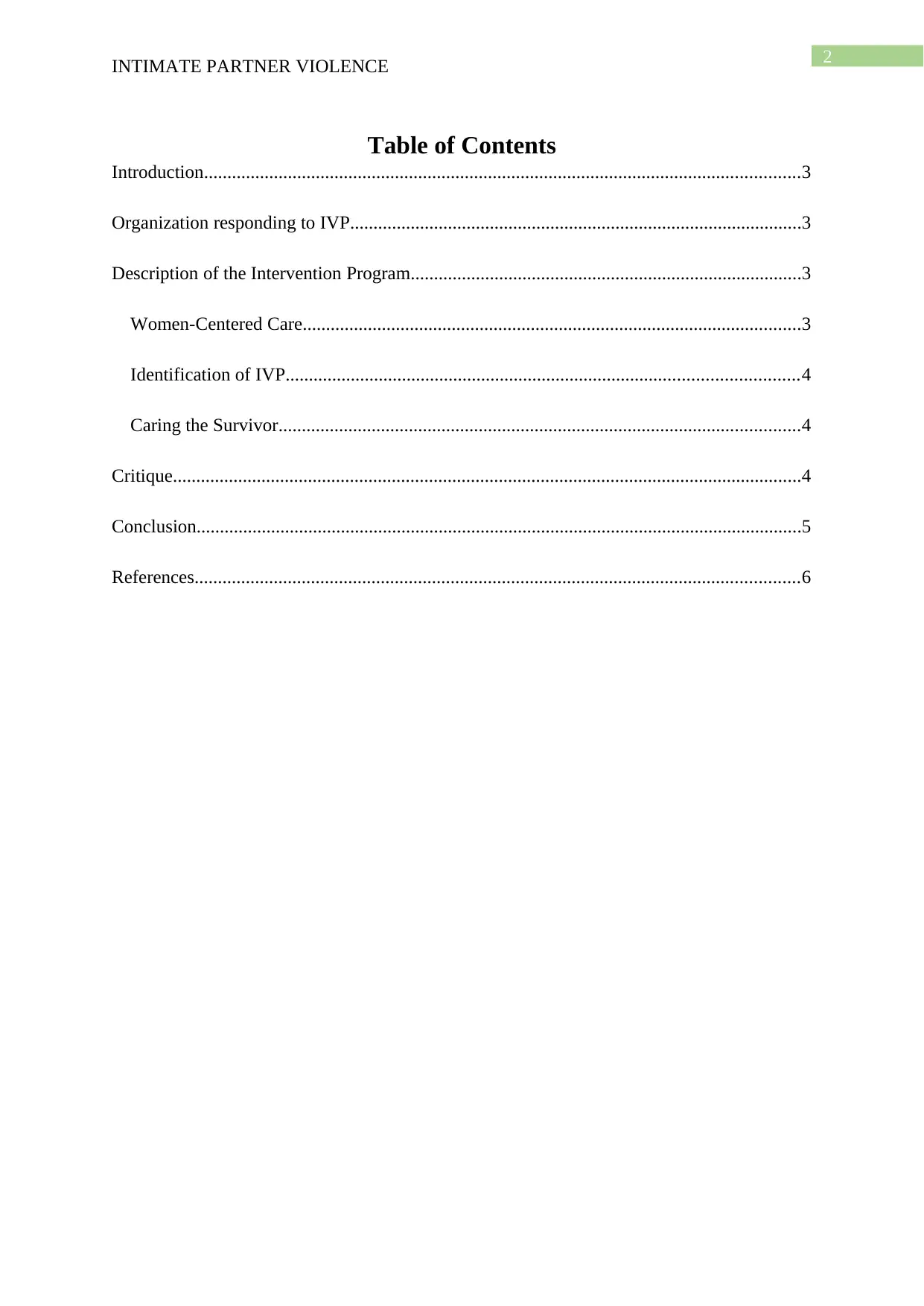
2
INTIMATE PARTNER VIOLENCE
Table of Contents
Introduction................................................................................................................................3
Organization responding to IVP.................................................................................................3
Description of the Intervention Program....................................................................................3
Women-Centered Care...........................................................................................................3
Identification of IVP..............................................................................................................4
Caring the Survivor................................................................................................................4
Critique.......................................................................................................................................4
Conclusion..................................................................................................................................5
References..................................................................................................................................6
INTIMATE PARTNER VIOLENCE
Table of Contents
Introduction................................................................................................................................3
Organization responding to IVP.................................................................................................3
Description of the Intervention Program....................................................................................3
Women-Centered Care...........................................................................................................3
Identification of IVP..............................................................................................................4
Caring the Survivor................................................................................................................4
Critique.......................................................................................................................................4
Conclusion..................................................................................................................................5
References..................................................................................................................................6
⊘ This is a preview!⊘
Do you want full access?
Subscribe today to unlock all pages.

Trusted by 1+ million students worldwide
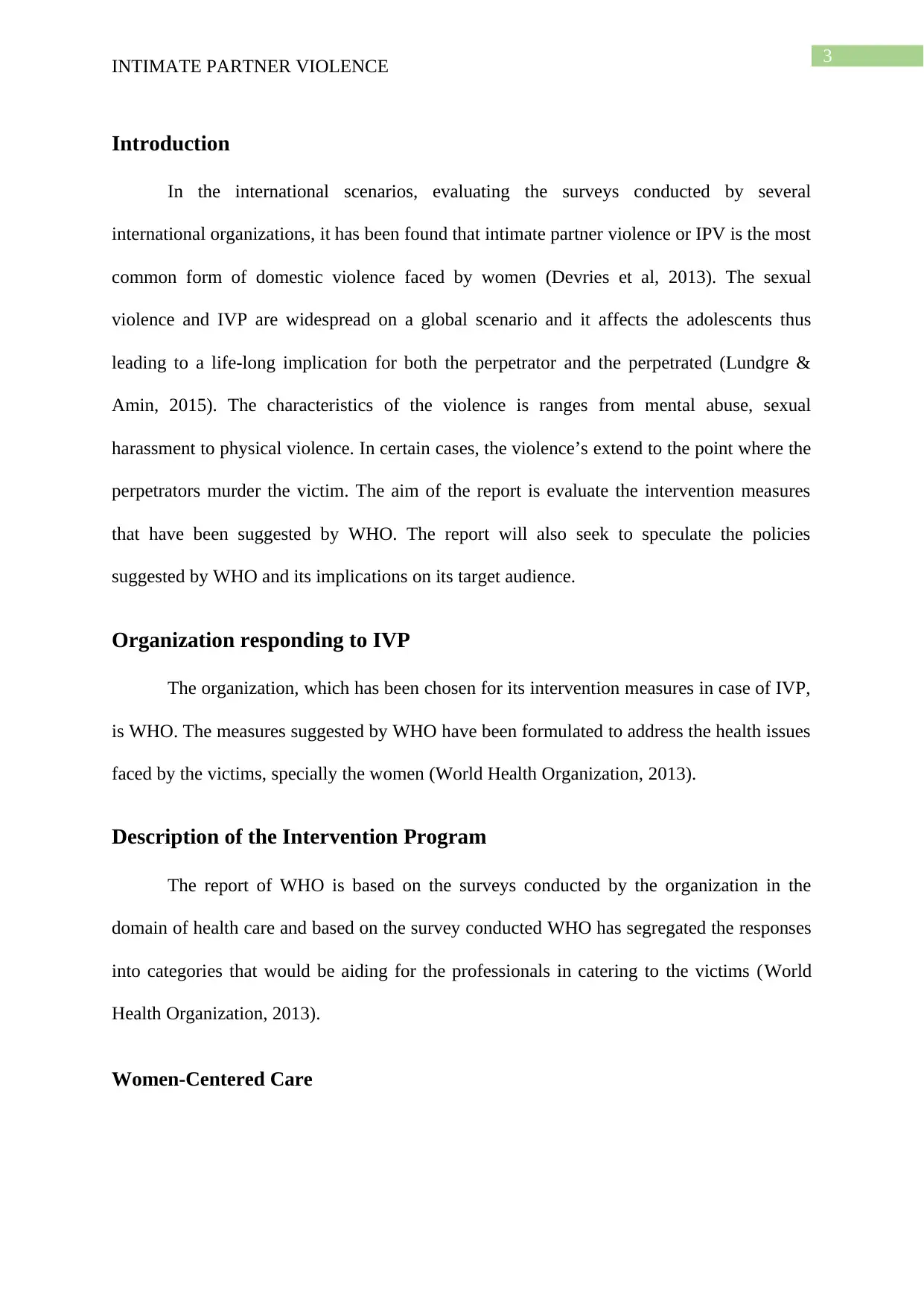
3
INTIMATE PARTNER VIOLENCE
Introduction
In the international scenarios, evaluating the surveys conducted by several
international organizations, it has been found that intimate partner violence or IPV is the most
common form of domestic violence faced by women (Devries et al, 2013). The sexual
violence and IVP are widespread on a global scenario and it affects the adolescents thus
leading to a life-long implication for both the perpetrator and the perpetrated (Lundgre &
Amin, 2015). The characteristics of the violence is ranges from mental abuse, sexual
harassment to physical violence. In certain cases, the violence’s extend to the point where the
perpetrators murder the victim. The aim of the report is evaluate the intervention measures
that have been suggested by WHO. The report will also seek to speculate the policies
suggested by WHO and its implications on its target audience.
Organization responding to IVP
The organization, which has been chosen for its intervention measures in case of IVP,
is WHO. The measures suggested by WHO have been formulated to address the health issues
faced by the victims, specially the women (World Health Organization, 2013).
Description of the Intervention Program
The report of WHO is based on the surveys conducted by the organization in the
domain of health care and based on the survey conducted WHO has segregated the responses
into categories that would be aiding for the professionals in catering to the victims (World
Health Organization, 2013).
Women-Centered Care
INTIMATE PARTNER VIOLENCE
Introduction
In the international scenarios, evaluating the surveys conducted by several
international organizations, it has been found that intimate partner violence or IPV is the most
common form of domestic violence faced by women (Devries et al, 2013). The sexual
violence and IVP are widespread on a global scenario and it affects the adolescents thus
leading to a life-long implication for both the perpetrator and the perpetrated (Lundgre &
Amin, 2015). The characteristics of the violence is ranges from mental abuse, sexual
harassment to physical violence. In certain cases, the violence’s extend to the point where the
perpetrators murder the victim. The aim of the report is evaluate the intervention measures
that have been suggested by WHO. The report will also seek to speculate the policies
suggested by WHO and its implications on its target audience.
Organization responding to IVP
The organization, which has been chosen for its intervention measures in case of IVP,
is WHO. The measures suggested by WHO have been formulated to address the health issues
faced by the victims, specially the women (World Health Organization, 2013).
Description of the Intervention Program
The report of WHO is based on the surveys conducted by the organization in the
domain of health care and based on the survey conducted WHO has segregated the responses
into categories that would be aiding for the professionals in catering to the victims (World
Health Organization, 2013).
Women-Centered Care
Paraphrase This Document
Need a fresh take? Get an instant paraphrase of this document with our AI Paraphraser
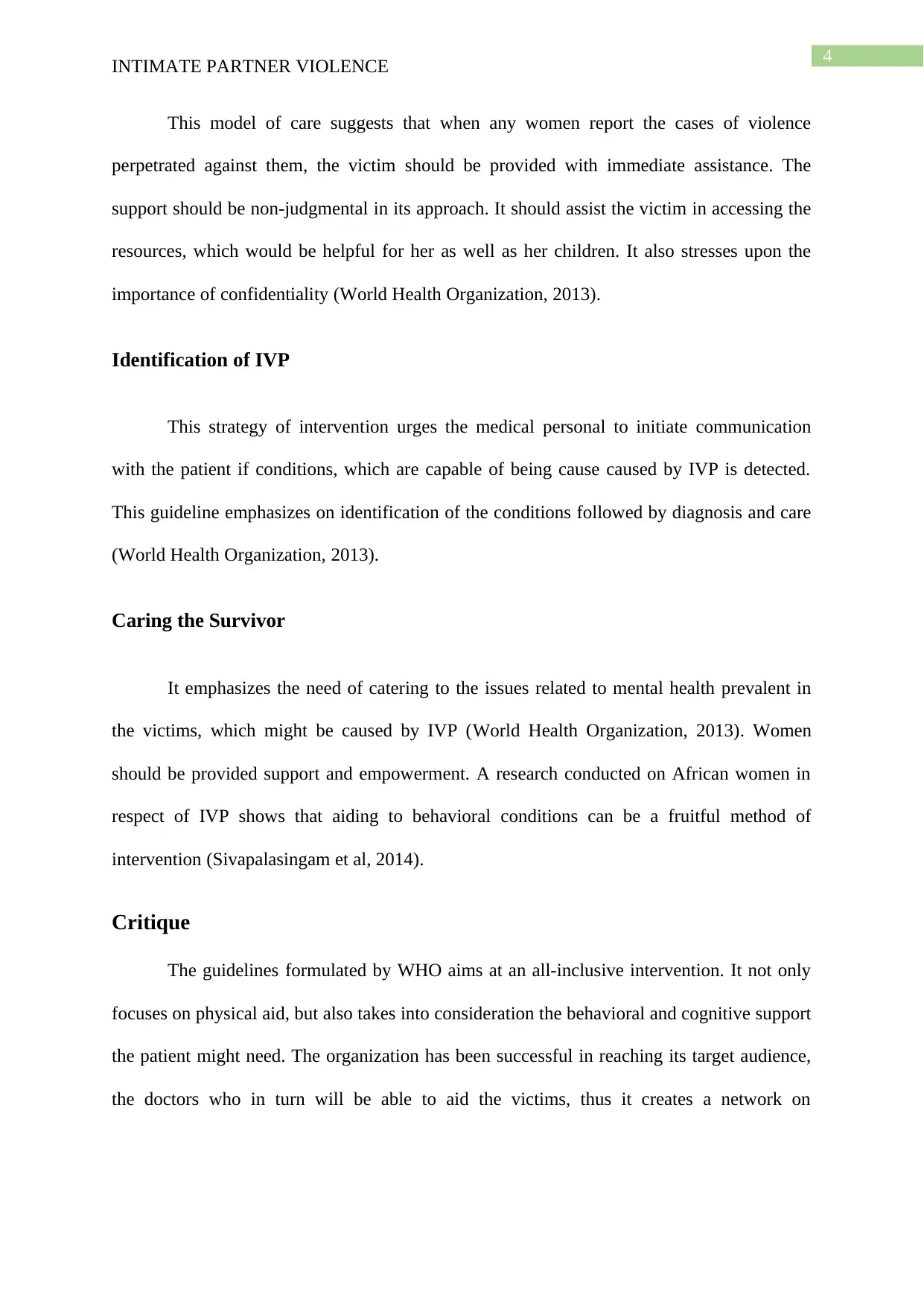
4
INTIMATE PARTNER VIOLENCE
This model of care suggests that when any women report the cases of violence
perpetrated against them, the victim should be provided with immediate assistance. The
support should be non-judgmental in its approach. It should assist the victim in accessing the
resources, which would be helpful for her as well as her children. It also stresses upon the
importance of confidentiality (World Health Organization, 2013).
Identification of IVP
This strategy of intervention urges the medical personal to initiate communication
with the patient if conditions, which are capable of being cause caused by IVP is detected.
This guideline emphasizes on identification of the conditions followed by diagnosis and care
(World Health Organization, 2013).
Caring the Survivor
It emphasizes the need of catering to the issues related to mental health prevalent in
the victims, which might be caused by IVP (World Health Organization, 2013). Women
should be provided support and empowerment. A research conducted on African women in
respect of IVP shows that aiding to behavioral conditions can be a fruitful method of
intervention (Sivapalasingam et al, 2014).
Critique
The guidelines formulated by WHO aims at an all-inclusive intervention. It not only
focuses on physical aid, but also takes into consideration the behavioral and cognitive support
the patient might need. The organization has been successful in reaching its target audience,
the doctors who in turn will be able to aid the victims, thus it creates a network on
INTIMATE PARTNER VIOLENCE
This model of care suggests that when any women report the cases of violence
perpetrated against them, the victim should be provided with immediate assistance. The
support should be non-judgmental in its approach. It should assist the victim in accessing the
resources, which would be helpful for her as well as her children. It also stresses upon the
importance of confidentiality (World Health Organization, 2013).
Identification of IVP
This strategy of intervention urges the medical personal to initiate communication
with the patient if conditions, which are capable of being cause caused by IVP is detected.
This guideline emphasizes on identification of the conditions followed by diagnosis and care
(World Health Organization, 2013).
Caring the Survivor
It emphasizes the need of catering to the issues related to mental health prevalent in
the victims, which might be caused by IVP (World Health Organization, 2013). Women
should be provided support and empowerment. A research conducted on African women in
respect of IVP shows that aiding to behavioral conditions can be a fruitful method of
intervention (Sivapalasingam et al, 2014).
Critique
The guidelines formulated by WHO aims at an all-inclusive intervention. It not only
focuses on physical aid, but also takes into consideration the behavioral and cognitive support
the patient might need. The organization has been successful in reaching its target audience,
the doctors who in turn will be able to aid the victims, thus it creates a network on
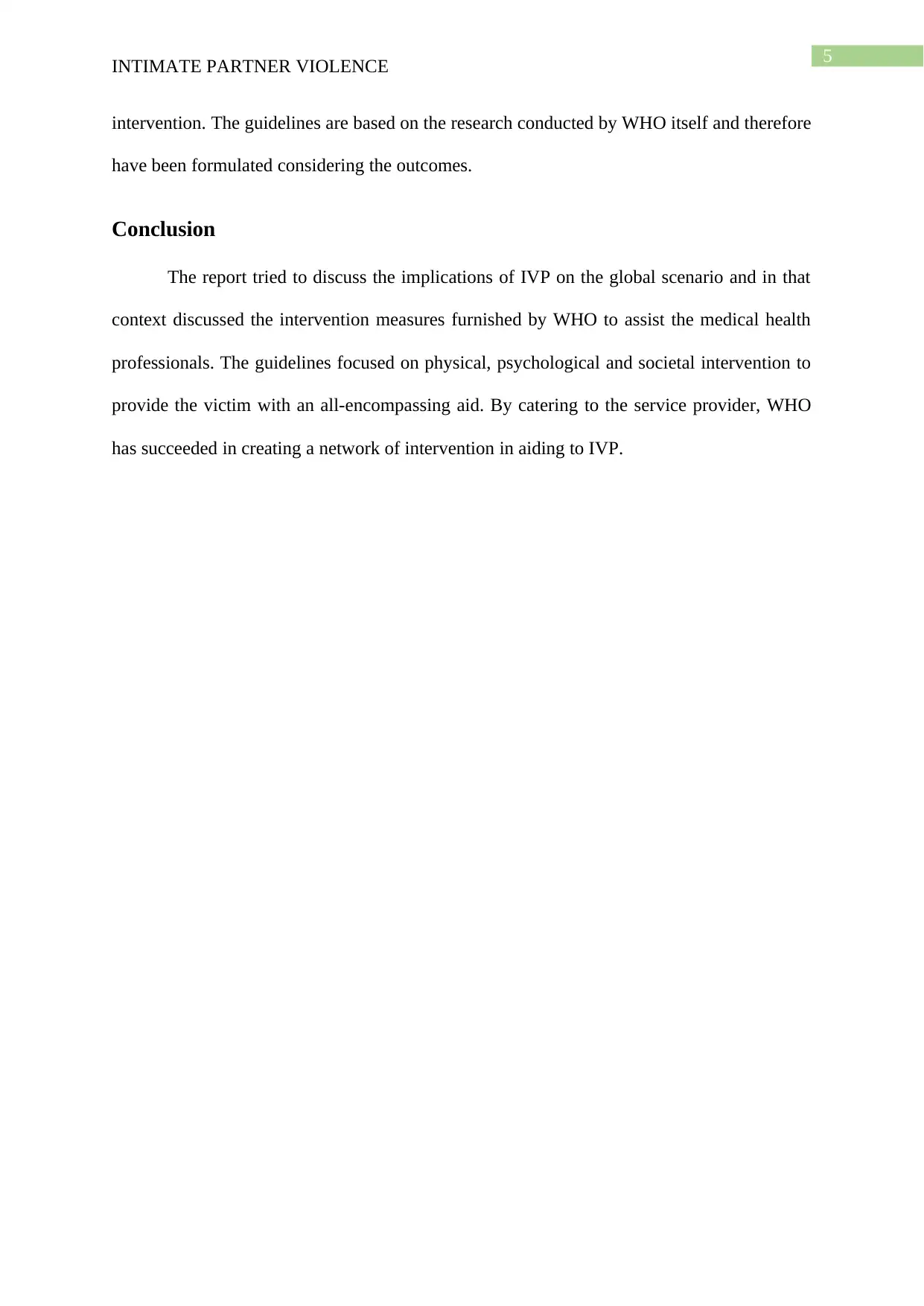
5
INTIMATE PARTNER VIOLENCE
intervention. The guidelines are based on the research conducted by WHO itself and therefore
have been formulated considering the outcomes.
Conclusion
The report tried to discuss the implications of IVP on the global scenario and in that
context discussed the intervention measures furnished by WHO to assist the medical health
professionals. The guidelines focused on physical, psychological and societal intervention to
provide the victim with an all-encompassing aid. By catering to the service provider, WHO
has succeeded in creating a network of intervention in aiding to IVP.
INTIMATE PARTNER VIOLENCE
intervention. The guidelines are based on the research conducted by WHO itself and therefore
have been formulated considering the outcomes.
Conclusion
The report tried to discuss the implications of IVP on the global scenario and in that
context discussed the intervention measures furnished by WHO to assist the medical health
professionals. The guidelines focused on physical, psychological and societal intervention to
provide the victim with an all-encompassing aid. By catering to the service provider, WHO
has succeeded in creating a network of intervention in aiding to IVP.
⊘ This is a preview!⊘
Do you want full access?
Subscribe today to unlock all pages.

Trusted by 1+ million students worldwide
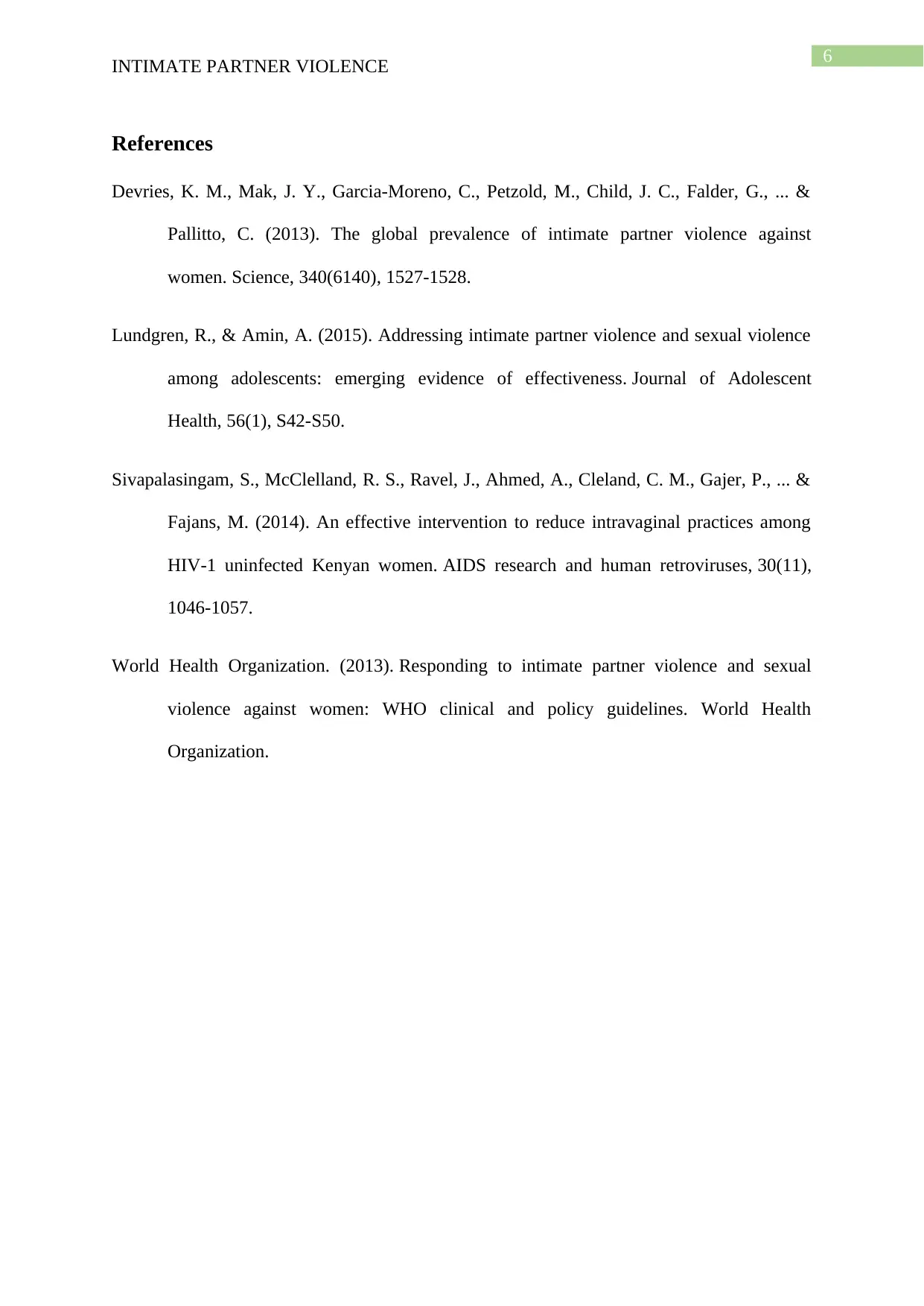
6
INTIMATE PARTNER VIOLENCE
References
Devries, K. M., Mak, J. Y., Garcia-Moreno, C., Petzold, M., Child, J. C., Falder, G., ... &
Pallitto, C. (2013). The global prevalence of intimate partner violence against
women. Science, 340(6140), 1527-1528.
Lundgren, R., & Amin, A. (2015). Addressing intimate partner violence and sexual violence
among adolescents: emerging evidence of effectiveness. Journal of Adolescent
Health, 56(1), S42-S50.
Sivapalasingam, S., McClelland, R. S., Ravel, J., Ahmed, A., Cleland, C. M., Gajer, P., ... &
Fajans, M. (2014). An effective intervention to reduce intravaginal practices among
HIV-1 uninfected Kenyan women. AIDS research and human retroviruses, 30(11),
1046-1057.
World Health Organization. (2013). Responding to intimate partner violence and sexual
violence against women: WHO clinical and policy guidelines. World Health
Organization.
INTIMATE PARTNER VIOLENCE
References
Devries, K. M., Mak, J. Y., Garcia-Moreno, C., Petzold, M., Child, J. C., Falder, G., ... &
Pallitto, C. (2013). The global prevalence of intimate partner violence against
women. Science, 340(6140), 1527-1528.
Lundgren, R., & Amin, A. (2015). Addressing intimate partner violence and sexual violence
among adolescents: emerging evidence of effectiveness. Journal of Adolescent
Health, 56(1), S42-S50.
Sivapalasingam, S., McClelland, R. S., Ravel, J., Ahmed, A., Cleland, C. M., Gajer, P., ... &
Fajans, M. (2014). An effective intervention to reduce intravaginal practices among
HIV-1 uninfected Kenyan women. AIDS research and human retroviruses, 30(11),
1046-1057.
World Health Organization. (2013). Responding to intimate partner violence and sexual
violence against women: WHO clinical and policy guidelines. World Health
Organization.
1 out of 7
Related Documents
Your All-in-One AI-Powered Toolkit for Academic Success.
+13062052269
info@desklib.com
Available 24*7 on WhatsApp / Email
![[object Object]](/_next/static/media/star-bottom.7253800d.svg)
Unlock your academic potential
Copyright © 2020–2025 A2Z Services. All Rights Reserved. Developed and managed by ZUCOL.





